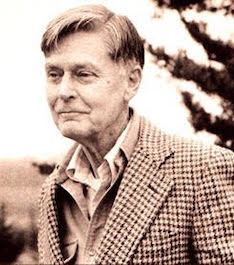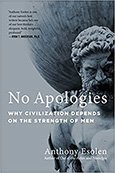A Warm and Loving Plenitude
- ANTHONY ESOLEN
Three men and a boy were sitting round a fire.
Join the worldwide Magnificat family by subscribing now: Your prayer life will never be the same!
 John Senior
John Senior1923-1999
A clear night sky stretched above them, glittering with stars. The air was crisp and cold, so it felt good, drinking hot coffee from a can.
"Keed," said one of the men, spitting genially to the side, "ah don't think you know yer own haid from the bizniss end of a horse." The other men laughed. The kid had made his usual mistakes today, but he was too happy to care overmuch.
"Then you can teach me," said the kid, "because I bet you know all there is to know about that business end." And they all laughed. They liked him, this handsome cowlicked boy from out east. They didn't know where he came from, because he never told them. He had left Long Island with a little money in his pocket, rode the bus till it ran out, and ended up in North Dakota, where he got a job with a group of cowboys. He was thirteen.
He'd wired his parents to tell them he was all right, but otherwise he was on his own. He was in search of something…real. School so far was not real. Drinking coffee at night on the open range was.
Reality exists
John Senior was in love with reality, and though he was brought up without any religious faith, his search for what was true and beautiful led him ultimately to God, the source of truth and beauty.
But one day Senior saw a nun with ashes on her forehead, and said to himself, "There's a woman who really believes something."
He'd go on, after his stint with the cowboys, to become a professor of English literature, especially poetry, and still he was not a Christian. We might say he was riding another bus with money in his pocket, money that would run out. Modernism in all of its various forms is money that runs out, though you don't end up with cowboys in North Dakota, drinking coffee, singing songs, and telling stories. You might end up at a university.
It's what Senior would call "the perennial heresy." It says, with Descartes, that we know things only by measurement, by their reduction to numbers. Or it says, with Sartre, that things do not exist until man interprets them. Or it agrees with those who say that reality is a "social construction." Or with the relativists, who sail on the sea without a moral compass or tiller, nor any knowledge of the heavens to guide them.
But one day Senior saw a nun with ashes on her forehead, and said to himself, "There's a woman who really believes something." His teaching brought him to medieval art, with its frank realism that was yet filled with rich symbols: not the bare realism of artists who get all the measurements right but lose the soul, the realest of the real. He read the Rule of Saint Benedict, and found there the two poles of man's existence, work — work in the good soil beneath your feet — and prayer, directed toward the stars and the God who made them. The world is not an empty illusion. It is, as Senior would call it, "a warm and loving plenitude."
Reality aims us toward no mere principle, but a Person, God; and in whom can we find God, if not in Christ? Theology is no mere system. It is a conversation about a Person, about God who took on human flesh, who really lived and loved, spoke to the crowds, ate with his friends, died upon a cross, and rose again and appeared to those friends in the flesh. Senior saw that the most important things in human life are not generalizations. They are encounters, face to face. You can generalize all you want about human beings, and you will still not know the person in the next room. Reality is more than abstract. It is singular and personal. That insight animated all that John Senior was, as a teacher, a man, and a Catholic scholar. Reading John Henry Newman brought him to the Person of Jesus. On Holy Thursday, 1960, John Senior, thirty-seven years old, was baptized a Catholic, along with his wife and their children.
Flowers in the desert, stars in the sky
This series is named How the Church Has Changed the World, but in Professor Senior's case, it should also be called How the Church Is Going to Change the World, because what John Senior went on to do was to show us the way out of our cultural and educational wasteland. Some people have taken that way, but more will and must, because all the alternatives end in a blank wall.
Senior ended up at the University of Kansas, where he led something called the Integrated Humanities Program. One of its graduates has sent me a copy of the brochure he received when he was a freshman. The front page features a drawing of Don Quixote perched atop that skin-and-bones horse of his, Rocinante, as, with his lance poised upright, he looks toward the stars. The drawing well expressed the motto of the program, Nascantur in admiratione: "Let them be born in wonder."
The students, starved for beauty and meaning, responded.
Senior, with two of his colleagues, Frank Nelick and Dennis Quinn, would every day violate all the modernist "truths" about education you can name. The modernists have a scorn for memory: it is almost the definition of modernism. So their students were required to commit poems to memory, and learn to recite them — or to sing them, if they were folk songs. Relativists taught that each person made his own moral reality. So the students sat quietly in class and listened, as the three professors, sitting in the front, discussed art and philosophy, theology and poetry, among themselves. People lost in abstraction forget that in man, mind and body are bound together. So the professors brought the students outside to look at the stars and learn their names and their ways. They taught the boys and girls how to waltz. They taught them how to sing songs.
Senior knew that culture could never be just dreamed up out of an ideologue's head, nor was it the same as mass-produced diversion. It had to do with both the soil and the stars: with cultivation of green growing things, the raising of animals, the building of real houses for real people, and our orientation toward the heavens.
The students, starved for beauty and meaning, responded. The program grew tenfold. Many students became Roman Catholics, and others returned to the Church they had left. Bishops, priests, nuns, teachers, founders of schools, presidents of colleges, husbands and wives with rich broods of happy children — all have come from the rich seedbed of that program, led by that eternal boy at heart. Of course that meant that the University of Kansas would have to shut it down.
Outposts of holiness and beauty
One of those students, a Marine, went on to found a Benedictine monastery in Oklahoma: Our Lady of Clear Creek. "Above all," says one of its founders, Brother Philip Anderson, "a monk is a man of prayer. His life says, God exists, and we have been created for him." More things have been done by men and women of prayer than this world can know. What we need above all in our time of haste and waste, Senior knew, is the habit of contemplation. Just as we do not really know a poem or a painting unless we behold it and open ourselves up to its beauty, so too, even if we are believers, we will find the great works of God closed to us, like a book in a strange language, unless we develop the habit of prayer in its most exalted form, that of the contemplative. Senior had asked, "What is Christian culture? It is essentially the Mass. That is not my or anyone's opinion or theory or wish but the central fact of two thousand years of history."
Schools indebted to the wisdom of John Senior have sprung up all over the United States. We are beginning, but only beginning, to see the fruits of what he set forth in The Restoration of Christian Culture. Now if only all the Catholic schools and colleges would condescend to come home and feed! And if churches everywhere, led by wise pastors, would but learn true poetry again, and art and music. And may we love more deeply that bodily and spiritual prayer that is the Mass, soaring above the mere talk of the day. I am seeing many a seedling springing up fresh and green.
 This is Meaghen Gonzalez, Editor of CERC. I hope you appreciated this piece. We curate these articles especially for believers like you.
This is Meaghen Gonzalez, Editor of CERC. I hope you appreciated this piece. We curate these articles especially for believers like you.
Please show your appreciation by making a $3 donation. CERC is entirely reader supported.

Acknowledgement
 Anthony Esolen. "How the Church Has Changed the World: A Warm and Loving Plenitude." Magnificat (August, 2019).
Anthony Esolen. "How the Church Has Changed the World: A Warm and Loving Plenitude." Magnificat (August, 2019).
Join the worldwide Magnificat family by subscribing now: Your prayer life will never be the same!
To read Professor Esolen's work each month in Magnificat, along with daily Mass texts, other fine essays, art commentaries, meditations, and daily prayers inspired by the Liturgy of the Hours, visit www.magnificat.com to subscribe or to request a complimentary copy.
The Author

Anthony Esolen is writer-in-residence at Magdalen College of the Liberal Arts and serves on the Catholic Resource Education Center's advisory board. His newest book is "No Apologies: Why Civilization Depends on the Strength of Men." You can read his new Substack magazine at Word and Song, which in addition to free content will have podcasts and poetry readings for subscribers.
Copyright © 2019 Magnificat



